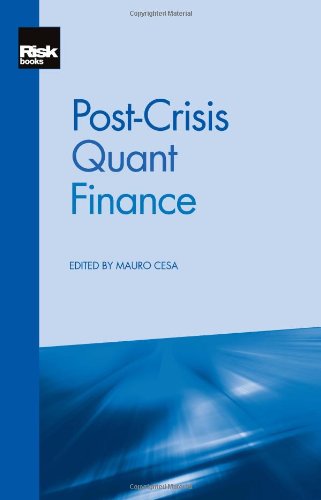

Most ebook files are in PDF format, so you can easily read them using various software such as Foxit Reader or directly on the Google Chrome browser.
Some ebook files are released by publishers in other formats such as .awz, .mobi, .epub, .fb2, etc. You may need to install specific software to read these formats on mobile/PC, such as Calibre.
Please read the tutorial at this link: https://ebookbell.com/faq
We offer FREE conversion to the popular formats you request; however, this may take some time. Therefore, right after payment, please email us, and we will try to provide the service as quickly as possible.
For some exceptional file formats or broken links (if any), please refrain from opening any disputes. Instead, email us first, and we will try to assist within a maximum of 6 hours.
EbookBell Team

0.0
0 reviews
Post-Crisis Quant Finance is a must-read for quants, statisticians, researchers, risk managers, analysts and economists looking for the latest practical quantitative models designed by expert market practitioners.
The financial crisis of 2007-8 shook the world of quantitative finance. First, it caused the industry as a whole to question long-held truisms which threw into doubt the pricing of even the most vanilla of derivatives. Second, the regulatory response dramatically reshaped the derivatives industry leading quants to shift their focus on capital, funding and of course risk.
The result has not been, as some doomsayers predicted, the end of quantitative finance or appreciation of its contribution to financial institutions and markets. Rather, quants have begun to rebuild. Aware now that frictions in markets under duress are the norm, not the exception, they are improving existing resilient models and developing new ones.
It is this new wave of developments that is the focus of Post-Crisis Quant Finance, edited and introduced by Risk magazine s Technical Editor, Mauro Cesa. Post-Crisis Quant Finance brings together for the first time 20 peer-reviewed papers from the Cutting Edge series of Risk, internationally recognised among the quantitative community.
Contributors include Jesper Andreasen, Marco Avellaneda, Lorenzo Bergomi, Christoph Burgard, Jon Gregory, Julien Guyon, Brian Huge, Mats Kjaer, Richard Martin, Vladimir Piterbarg, Michael Pykhtin and Robin Stuart.
The book is divided into three sections:
I - Derivatives pricing
II - Asset and risk management
III - Counterparty credit risk
This book outlines practically relevant solutions to the complexities faced by quants post-crisis. Each of the 20 chapters targets a specific technical issue including pricing, hedging and risk management of financial securities.
Post-Crisis Quant Finance is a must-read for quants, statisticians, researchers, risk managers, analysts and economists looking for the latest practical quantitative models designed by expert market practitioners.